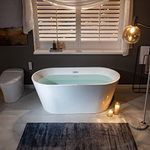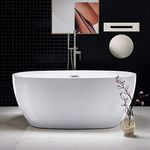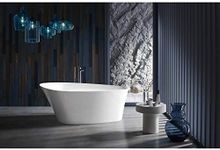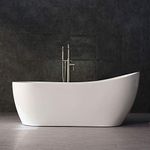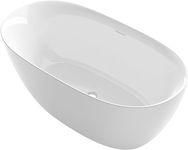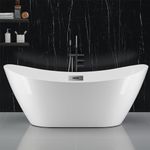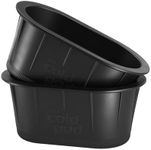Buying Guide for the Best Freestanding Baths
Choosing the right freestanding bath can significantly enhance your bathroom's aesthetic and functionality. When selecting a freestanding bath, it's important to consider various factors to ensure it meets your needs and preferences. Here are some key specifications to help you make an informed decision.MaterialThe material of a freestanding bath affects its durability, weight, and heat retention. Common materials include acrylic, cast iron, and stone resin. Acrylic is lightweight and retains heat well, making it a popular choice for many. Cast iron is extremely durable and retains heat for longer periods, but it is very heavy and may require reinforced flooring. Stone resin offers a luxurious feel and excellent heat retention but can be quite expensive. Choose a material based on your preference for durability, heat retention, and the structural capacity of your bathroom floor.
SizeThe size of the freestanding bath is crucial for both comfort and fitting into your bathroom space. Sizes typically range from small (around 1500mm) to large (over 1800mm). A smaller bath is suitable for compact bathrooms and can still provide a comfortable soak, while a larger bath offers more space for relaxation but requires a larger bathroom. Measure your bathroom space carefully and consider how much room you want around the bath for ease of movement and cleaning.
ShapeFreestanding baths come in various shapes, including oval, rectangular, and slipper. Oval baths are the most common and offer a classic look with comfortable contours. Rectangular baths provide a modern, sleek appearance and can fit well against a wall. Slipper baths have a higher backrest on one end, offering extra support and comfort for lounging. Choose a shape that complements your bathroom design and provides the level of comfort you desire.
CapacityThe water capacity of a freestanding bath determines how much water it can hold, which affects your bathing experience. Capacities can range from around 150 liters to over 300 liters. A higher capacity bath allows for a deeper soak, which can be more relaxing, but it also means more water usage. Consider your preference for bath depth and the practicality of water usage in your home when selecting the capacity.
WeightThe weight of a freestanding bath is important for installation and the structural integrity of your bathroom floor. Lighter materials like acrylic are easier to install and may not require additional floor support. Heavier materials like cast iron or stone resin may need reinforced flooring to support the weight. Ensure your bathroom floor can handle the weight of the bath you choose, and consult a professional if necessary.
StyleThe style of a freestanding bath can greatly influence the overall look of your bathroom. Styles range from traditional clawfoot designs to modern, minimalist tubs. Traditional styles often feature ornate details and can add a vintage charm to your bathroom, while modern styles offer clean lines and a contemporary feel. Choose a style that matches your bathroom decor and personal taste to create a cohesive and appealing space.

